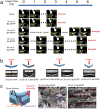Enhancing the Mechanical Toughness of Epoxy-Resin Composites Using Natural Silk Reinforcements
- PMID: 28931868
- PMCID: PMC5607334
- DOI: 10.1038/s41598-017-11919-1
Enhancing the Mechanical Toughness of Epoxy-Resin Composites Using Natural Silk Reinforcements
Abstract
Strong and tough epoxy composites are developed using a less-studied fibre reinforcement, that of natural silk. Two common but structurally distinct silks from the domestic B. mori/Bm and the wild A. pernyi/Ap silkworms are selected in fabric forms. We show that the toughening effects on silk-epoxy composites or SFRPs are dependent on the silk species and the volume fraction of silk. Both silks enhance the room-temperature tensile and flexural mechanical properties of the composite, whereas the more resilient Ap silk shows a more pronounced toughening effect and a lower critical reinforcement volume for the brittle-ductile transition. Specifically, our 60 vol.% Ap-SFRP displays a three-fold elevation in tensile and flexural strength, as compared to pure epoxy resin, with an order of magnitude higher breaking energy via a distinct, ductile failure mode. Importantly, the 60 vol.% Ap-SFRP remains ductile with 7% flexural elongation at lower temperatures (-50 °C). Under impact, these SFRPs show significantly improved energy absorption, and the 60 vol.% Ap-SFRP has an impact strength some eight times that of pure epoxy resin. The findings demonstrate both marked toughening and strengthening effects for epoxy composites from natural silk reinforcements, which presents opportunities for mechanically superior and "green" structural composites.
Conflict of interest statement
The authors declare that they have no competing interests.
Figures




References
-
- Qu P, Sun X, Ping L, Zhang D, Jia Y. A new numerical model for the analysis on low-velocity impact damage evolution of carbon fiber reinforced resin composites. J. Appl. Polym. Sci. 2016;134:44374.
-
- Nash NH, Young TM, Mcgrail PT, Stanley WF. Inclusion of a thermoplastic phase to improve impact and post-impact performances of carbon fibre reinforced thermosetting composites — A review. Mater. Design. 2015;85:582–597. doi: 10.1016/j.matdes.2015.07.001. - DOI
-
- Río GD, Zaera R, Barbero E, Navarro C. Damage in CFRPs due to low velocity impact at low temperature. Compos. Part. B-Eng. 2005;36:41–50. doi: 10.1016/j.compositesb.2004.04.003. - DOI
-
- Chen Y, Wang S, Liu B, Zhang J. Effects of geometrical and mechanical properties of fiber and matrix on composite fracture toughness. Compos. Struct. 2015;122:496–506. doi: 10.1016/j.compstruct.2014.12.011. - DOI
Publication types
LinkOut - more resources
Full Text Sources
Other Literature Sources

